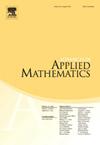On (joint) equidistributions of mesh patterns 123 and 132 with symmetric shadings
IF 1.3
3区 数学
Q3 MATHEMATICS, APPLIED
引用次数: 0
Abstract
A notable problem within permutation patterns that has attracted considerable attention in literature since 1973 is the search for a bijective proof demonstrating that 123-avoiding and 132-avoiding permutations are equinumerous, both counted by the Catalan numbers. Despite this equivalence, the distributions of occurrences of the patterns 123 and 132 are distinct. When considering 123 and 132 as mesh patterns and selectively shading boxes, similar scenarios arise, even when avoidance is defined by the Bell numbers or other sequences, rather than the Catalan numbers.
However, computer experiments suggest that mesh patterns 123 and 132 may indeed be jointly equidistributed. Furthermore, by considering symmetric shadings relative to the diagonal, a maximum of 93 equidistributed pairs can potentially exist. This paper establishes 75 joint equidistributions, leaving the justification of the remaining cases as open problems. As a by-product, we also prove 36 relevant non-symmetric joint equidistributions. All our proofs are bijective and involve swapping occurrences of the patterns in question, thereby demonstrating their joint equidistribution. Our findings are a continuation of the systematic study of distributions of short-length mesh patterns initiated by Kitaev and Zhang in 2019.
关于具有对称阴影的 123 和 132 网格图案的(联合)等分布情况
自1973年以来,在文献中引起相当大关注的排列模式中的一个值得注意的问题是寻找双客观证明,证明123-避免和132-避免排列是等量的,两者都由加泰罗尼亚数计算。尽管存在这种等价性,模式123和132出现的分布是不同的。当考虑123和132作为网格模式和选择性阴影框时,类似的情况也会出现,即使避免是由贝尔数字或其他序列定义的,而不是加泰罗尼亚数字。然而,计算机实验表明,网格模式123和132可能确实是共同均匀分布的。此外,通过考虑相对于对角线的对称阴影,可能存在最多93个等分布对。本文建立了75个联合等分配,将其余情况的正当性作为悬而未决的问题。作为副产物,我们也证明了36个相关的非对称联合等分布。我们所有的证明都是客观的,并且涉及到所讨论的模式的交换出现,从而证明了它们的联合等分布。我们的研究结果是Kitaev和Zhang于2019年发起的对短长度网格模式分布的系统研究的延续。
本文章由计算机程序翻译,如有差异,请以英文原文为准。
求助全文
约1分钟内获得全文
求助全文
来源期刊

Advances in Applied Mathematics
数学-应用数学
CiteScore
2.00
自引率
9.10%
发文量
88
审稿时长
85 days
期刊介绍:
Interdisciplinary in its coverage, Advances in Applied Mathematics is dedicated to the publication of original and survey articles on rigorous methods and results in applied mathematics. The journal features articles on discrete mathematics, discrete probability theory, theoretical statistics, mathematical biology and bioinformatics, applied commutative algebra and algebraic geometry, convexity theory, experimental mathematics, theoretical computer science, and other areas.
Emphasizing papers that represent a substantial mathematical advance in their field, the journal is an excellent source of current information for mathematicians, computer scientists, applied mathematicians, physicists, statisticians, and biologists. Over the past ten years, Advances in Applied Mathematics has published research papers written by many of the foremost mathematicians of our time.
 求助内容:
求助内容: 应助结果提醒方式:
应助结果提醒方式:


